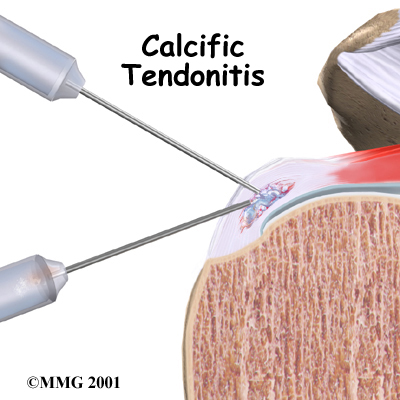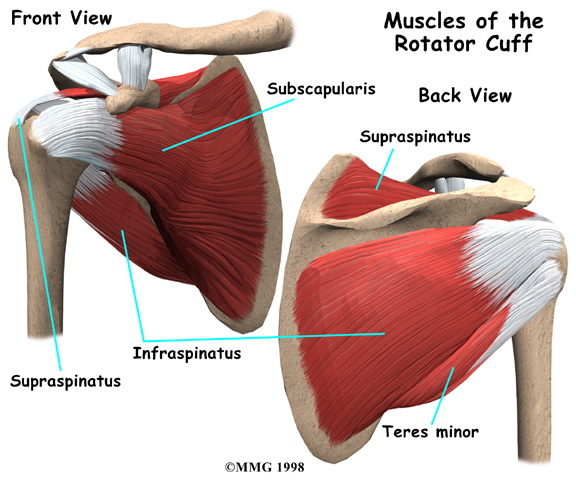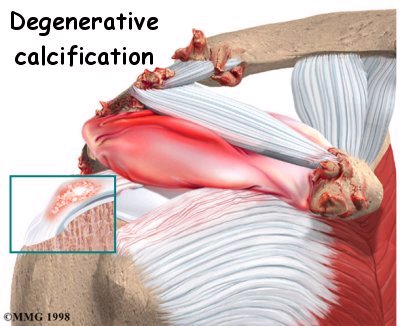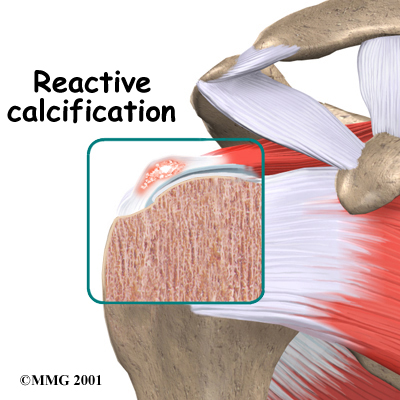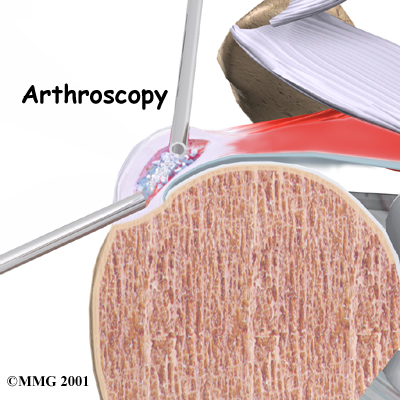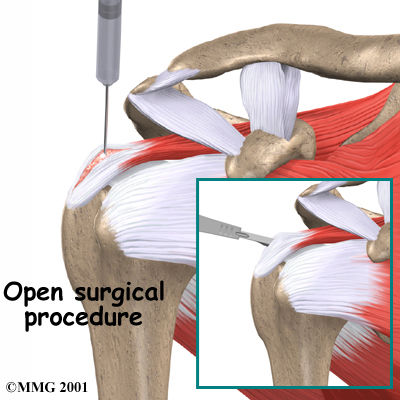How can I get my pain under control?
Nonsurgical Treatment
Your doctor's first goal will be to help control your pain and inflammation. Initial treatment is likely to be a short amount of rest and also anti-inflammatory medication, such as ibuprofen. The anti-inflammatory medicine is used mainly to control pain. Your doctor may suggest a cortisone injection if your pain remains severe even after trying other nonsurgical treatments. Cortisone is a very powerful steroid. Cortisone can be very effective at temporarily easing inflammation and swelling.
During the time when the calcium deposits are being reabsorbed, the pain can be especially bad. Your doctor may suggest a procedure called lavage in which an attempt is made to try to remove the calcium deposit by inserting two large needles into the area and rinsing with sterile saline (saline is simply a saltwater solution.) Sometimes lavage breaks the calcium particles loose and they can then be removed with the needles. Getting rid of the calcium deposits can help speed up the healing. Even when lavage fails to remove calcium deposits, it may reduce pressure in the tendon, leading to less pain.
Shock wave therapy is another form of nonsurgical treatment. It uses a machine to generate shock wave pulses to the sore area. Patients generally receive the treatment once each week for up to three weeks. The impulses are thought to help break up the deposit so the body can more easily absorb it. Recent studies indicate that this form of treatment does help ease pain and reduce the size of the deposit.
Physical therapy at STAR Physical Therapy can also greatly assist with controlling your pain and inflammation, and will be crucial to ensuring that you recover the range of motion, strength, and control of your shoulder if you have been diagnosed with calcific tendonitis.
Nonsurgical Rehabilitation
On your first visit to STAR Physical Therapy, your physical therapist will take a history of your injury and focus on finding out which movements in your everyday life, such as sleeping, reaching overhead or reaching behind your back, cause you discomfort. If you have already seen your doctor and had an x-ray, the diagnosis should be clear. If you have not seen your doctor, then we will further assess your ability to move your shoulder into different ranges of movement, as well as check the strength and stability of your shoulder to help us decide that your pain is indeed caused by calcific tendonitis. Once calcific tendonitis is suspected, we will send you to your doctor to get an x-ray to confirm the problem.
Due to the different types of calcific tendonitis and because of the progressive stages of reactive calcific tendonitis, your pain level may vary. Physical therapy can be very effective in decreasing the pain as well as the inflammation caused by this injury. Your physical therapist may use electrical modalities for this purpose. Ultrasound is particularly useful for this and can even decrease the size of the calcium deposit in some cases, although it may require several treatments to do so (4X a week for 6 weeks has been recommended.) Heat and/or ice can also be very useful in decreasing pain and inflammation, as can other modalities such as interferential current. Your physical therapist may also use massage around the shoulder to ease your discomfort and assist with the associated inflammation.
The next part of our treatment will focus on regaining the range of motion, strength, and coordination in your shoulder. Your physical therapist at STAR Physical Therapy will prescribe a series of stretching and strengthening exercises that you will practice in the clinic and also learn to do as part of a home exercise program. Due to the initial pain you may feel, the range of motion exercises will first be done passively, which means that you do not use your own muscles of the injured shoulder to lift the joint into its full ranges of motion. Maintaining passive range of motion is particularly important in the early stages of treating calcific tendonitis because the pain associated with this injury often limits you from using the shoulder above shoulder height. If, however, you do not passively maintain the overhead range in your shoulder then your shoulder is at significant risk of becoming stiff and not being able to move into this range even once the acute pain and inflammation caused by the calcific tendonitis has disappeared.
Passive range of motion exercises may include the use of rehabilitation equipment such as pulleys and poles, or your therapist may just ask you to use your non-painful arm to move your painful one. In some cases your physical therapist themselves may move your shoulder for you; again, this is considered passive motion. An upper body bike may also be useful in the early stages of rehabilitation to improve range of motion and encourage coordinated movement of the entire upper limb, as long as it can be used without causing discomfort.
In order gain strength in your rotator cuff muscles of the shoulder joint, as well as the other supporting muscles of the shoulder, your physical therapist at STAR Physical Therapy will also prescribe specific strengthening exercises which may, depending on your stage of injury, initially only involve isometric strengthening. Isometric strengthening exercises involve tightening your muscles without actually moving the associated joint. Isometric exercises work the muscles without straining the injured or painful tissues. Your physical therapist will teach you how to use your other hand or wall for resistance while you flex and tighten your muscles, creating an isometric contraction of the shoulder muscles. Your therapist will then progress your exercises so that you are strengthening the muscles through their available ranges of motion. This may involve using light-weights or Theraband to add resistance for your upper limb. Adequate strength and endurance in the rotator cuff muscles throughout a variety of ranges of motion, including over shoulder height, is needed to ensure full functioning of the shoulder. Adequate strength will also decrease the pressure on the calcium deposits in the shoulder, which may lead to less pain and a quicker recovery.
A crucial component to any shoulder rehabilitation program is the ability for you to regain what is called ‘proprioceptive control’ of your shoulder joint. Proprioception is the ability to know where your body is without looking at it. For example, normally each time you reach overhead with your hand, your mind does not consciously have to think about doing the action, yet all the muscles of the shoulder (and elbow, wrist, and upper back) coordinate the action just right so you can perform the movement without any discomfort or pinching. When you have pain in a joint, or the tissues of the joint have been injured, your proprioception declines. Any period of decreased mobility of the joint will also add to this decline. If the proprioceptive control of your shoulder is poor then the ability to use your shoulder naturally in all ranges of movement without causing any pain or pinching, or unnecessary motion, declines, and your shoulder is at risk of increased wear and tear, and developing another injury. The joint between your shoulder blade and your thoracic spine (called the scapulothoracic joint) is particularly important to the overall proprioceptive control of the shoulder joint. The outer edge of the shoulder blade actually creates the socket of the shoulder joint. Together, the scapulothoracic joint and the shoulder joint itself (including the rotator cuff muscles) create the complete shoulder girdle; the entire shoulder girdle must operate together for normal shoulder motion. Controlled shoulder girdle motion along with adequate rotator cuff strength keeps the ball of the shoulder joint properly centered in the socket of the joint and avoids any pain or undesired motion of the joint. This control and strength is particularly essential when using your limb near or above shoulder height and especially during rapid or repetitive arm movements such as throwing.
For this reason, your physical therapist will teach you how to properly control your shoulder girdle during your rehabilitation exercises but will also educate you on transferring this control to your everyday activities. Again, this will prevent excessive wear and tear on your shoulder joint even during the repetition of normal everyday tasks.
As you improve in your ability to control the shoulder girdle your physical therapist will introduce more difficult dynamic exercises for your shoulder including exercises that simulate your daily tasks, or if you are an athlete or simply do recreational sport, those shoulder motions that simulate your sport. Simple proprioceptive exercises might include activities such as rolling a ball on a surface with your hand, holding a weight up overhead while moving your shoulder, or pushups on an unstable surface. Advanced exercises may include activities such as reaching for and lowering a weight, ball throwing, catching overhead, or a simulated swimming stroke or overhead volleyball spike.
Finally, as part of your shoulder rehabilitation, your physical therapist will also remind you about maintaining good shoulder posture at all times even when just sitting or using your upper limb in activities below shoulder height, such as working on the computer. Rounded shoulders in any position crowds the shoulder joint and can lead to overall shoulder impingement, more pressure on the calcified area of your tendon, and poor recovery from the injury or a new episode of shoulder pain. Simple changes in the way you sit or stand and how you use your shoulder, neck and thoracic spine throughout the day can ease your pain and help you avoid further problems.
In addition to rehabilitating your shoulder joint itself, at STAR Physical Therapy we highly recommend maintaining the rest of your body’s fitness with regular exercise even while you recover from the calcific tendonitis in your shoulder. Cardiovascular fitness can be maintained with lower extremity fitness activities such as walking or using a stationary bike or stepper machine. None of these exercises should cause discomfort to your shoulder; if they do, discuss modifying the activity with your physical therapist.
You will notice improvements in the functioning of your shoulder even after just a few treatments with your physical therapist at STAR Physical Therapy. Full recovery, however, will require consistent treatment for approximately 6 weeks. Your home exercise program will likely need to be continued for 3-4 months or longer. If your shoulder joint is not recovering as your % physiotherapist% would expect it should, or if your pain becomes unmanageable, your physical therapist will suggest that you return to your doctor or see an Orthopaedic Surgeon. More radical treatment measures, such as surgery, may be needed in your case to deal with the calcification.
STAR Physical Therapy provides services for physical therapy in Fairport and Rochester.
